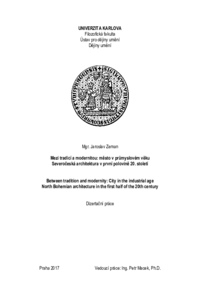Mezi tradicí a modernitou: město v průmyslovém věku. Severočeská architektura v první polovině 20. století
Between tradition and modernity: City in the industrial age. North Bohemian architecture in the first half of the 20th century
dizertační práce (OBHÁJENO)

Zobrazit/
Trvalý odkaz
http://hdl.handle.net/20.500.11956/94129Identifikátory
SIS: 147108
Kolekce
- Kvalifikační práce [23200]
Autor
Vedoucí práce
Oponent práce
Švácha, Rostislav
Vorlík, Petr
Fakulta / součást
Filozofická fakulta
Obor
Dějiny výtvarného umění
Katedra / ústav / klinika
Ústav pro dějiny umění
Datum obhajoby
6. 9. 2017
Nakladatel
Univerzita Karlova, Filozofická fakultaJazyk
Čeština
Známka
Prospěl/a
Klíčová slova (česky)
Architektura, urbanismus, severní Čechy, Sasko, Liberec, Ústí nad Labem, Jablonec nad Nisou, Plzeň, Saská Kamenice, německy hovořící architektiKlíčová slova (anglicky)
Architecture, urbanism, Northern Bohemia, Saxony, Liberec, Ústí nad Labem, Jablonec nad Nisou, Plzeň, Chemnitz, German-speaking architectsSeveročeská průmyslová oblast, osídlená především německým obyvatelstvem, prošla od poloviny 19. století nebývalým urbanistickým a demografickým růstem. Zásadní zlom znamenal především nástup průmyslové revoluce, neboť nejvýrazněji se na její podobě podepsala následující období. Charakteristickým znakem zdejších měst je překotný urbanistický rozvoj, který šel ruku v ruce se stavebním kvasem. Tím vznikla působivá skrumáž vzájemně koexistujících průmyslových areálů, honosných vil, pompézních veřejných budov, velkorysých zahradních čtvrtí a maloměstské zástavby, vytvářející zdejšího svérázného genia loci. Pohraniční oblasti byly již odedávna rušnou křižovatku kultur, dějin a ideologií, v níž se mísili a vzájemně ovlivňovali Češi, Němci a Židé a odráží tak složité etnické vztahy na území dnešní České republiky. Práce se zaměřuje na architekturu českých Němců, která tvořila přirozený protipól architektuře české majority. Jejím cílem je tento "druhý proud" kultury zasadit do širšího středoevropského kontextu, najít a definovat specifika stavební produkce českých Němců. Za tímto účelem byla zvolena trojice průmyslových aglomerací, Ústí nad Labem, Liberec a Jablonec nad Nisou, které jsou zároveň srovnány s obdobnými lokalitami v českém (Plzeň) i německém (Saská Kamenice) prostředí.
From the mid-nineteenth century the North Bohemian industrial area, populated mostly by Germans, experienced an unprecedented urban and demographic growth. The onset of the industrial revolution meant a major breaking point, in particular because the following periods shaped it most notably.The characteristic trait of the cities is a precipitous urban development with building boom. Thereby an impressive scrum of mutually coexisting industrial complexes, palatial villas, spectacular public buildings, generous garden districts and small town housing projects originated, creating the peculiar local genius loci. The border areas have always been a busy crossroads of cultures, histories and ideologies, in which Czechs, Germans and Jews mingled and interacted with each other, and thus they reflect the complex ethnic relations in the territory of today's Czech Republic. The Thesis focuses on the architecture of Czech Germans which formed the natural counterpart to the architecture of the Czech majority. The aim is to set this "second stream" of culture into a wider Central European context and find and define the specifics of the buildings production of Czech Germans. For this purpose, the trio of industrial agglomerations Usti nad Labem, Liberec and Jablonec nad Nisou was chosen, which are also compared...
